At Nerstane we are aware that there are a range of breeding and selection systems used in the Merino industry. Our aim is to maximise genetic progress in achieving our breeding objectives. If there is a system available that will do that more efficiently than our current index based system we would be very keen to capitalise on it.
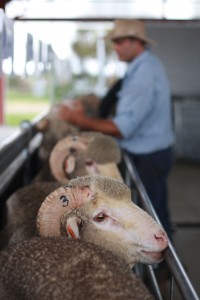
Our aim is to maximise profitability for our clients
We spend a considerable amount of time and effort in keeping up to date with breeding technology. Our research to date, combined with the results we have achieved, indicates that our current system is the best available. Feedback from our clients supports this belief.
The Nerstane breeding program is designed to maximise genetic progress and to deliver maximum benefits to our commercial clients. To appreciate the Nerstane breeding system it is necessary to be familiar with the major events that occur during the year leading up to the selection of stud sires, sale rams, stud and flock ewes. The selection system is based on accurate, measured data and thorough visual assessments.
The aim of all selection programs should be to identify those animals with the best genes for the traits in the breeding objective rather than those animals which simply look the best.
An animal’s performance is determined by its genes and by how it is managed (i.e. nutrition and health and by other non genetic or environmental effects). Examples of non genetic effects include the difference in age due to the spread of lambing, the age of a lamb’s dam (maidens lambs do not grow as well as those from adult ewes), the birth status of the lamb i.e. single or multiple or the paddock effect if a drop of lambs is not run as one mob until assessment.
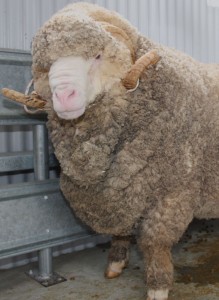
Selection must be based on accurate and unbiased data
At Nerstane both the ram and ewe selection programs are organised to account for these factors so that ALL selection decisions are based on accurate and unbiased data.
Ewe and ram weaners are managed as separate mobs and receive equal management until shearing when performance data is collected on measured traits. The effect of the differences in age due to the spread of lambing is eliminated by weaner shearing; dam age is recorded for all lambs and appropriate adjustments are made to the progeny of maidens. Similarly twin and single born animals are identified and their performance adjusted.
The use of a two stage selection system for both stud ewes and potential sires has been incorporated into the Nerstane system because it has the potential to improve the accuracy of selection by as much as 25%. This system involves combining the fleece weight and fibre diameter performance from two shearings and re ranking the animals in relation to the whole drop.
All fibre testing is performed at a Rampower accredited laboratory. The analysis of all performance and pedigree records at Nerstane is carried out by NSW Agriculture’s Advanced Breeding Services based at Orange and Sheep Genetics Australia. Additionally, every opportunity is seized to increase the rate of genetic gain. Breeding technologies such as artificial insemination (AI) and multiple ovulation embryo transfer (MOET) have been used for some years to capitalise on superior genetic material both from within the Nerstane stud and from other studs in the industry.
AI is a very efficient strategy to spread the influence of superior sires and MOET in a similar manner is used to make the best use of the high performing ewes.
The program has proven to be very successful over the years with some of our best sires including N2, N142, N43, N949, and N910 all being ET born lambs.
Brucellocis Accredited Free Flock
MN3 Status for National Johne Disease Program
Declared Footrot Free
Click on these links for more specific information:
The Ram Selection Program | The Progeny Testing Program | The Ewe Selection Program
The Ram Selection Program
| TIMING | SELECTION EVENT |
| August/September | Lambing – lasts for six weeks; majority born in first three weeks |
| October | Lamb marking – all lambs tagged and any faults noted |
| December | Weaning and tip shearing using Bioclip to ensure accurate fleece weights at 12 months |
| September | Classing at 12 months of age – 20 to 50% are identified as visual culls. All rams are scored for a range of visually assessed traits |
| September (early) |
Hogget rams are shorn and measured for fleece weight and fibre diameter testing (1st Stage Test). All visual culls are also measured and recorded for progeny test purposes. All fleeces are scored for Style and Fleece rot incidence as they come over the table. |
| October | Body weights recorded |
| November/December | Faecal samples collected for worm egg count data to be used for selection for worm resistance. |
| December/January | Ram classing with the aid of fleece measurements; 50 Reserves are selected. Nerstane on-property sale team selected. Sale flock rams are selected and divided into six grades mainly on performance. |
| February | Flock rams available |
| February (late) |
Reserve Sires are shorn, fleece weighed and fibre diameter tested (2nd Stage Test). Results are used to aid in the final selection of young sires which will be progeny tested. |
The use of visual classing combined with measurement of important traits is a feature of the ram selection program.
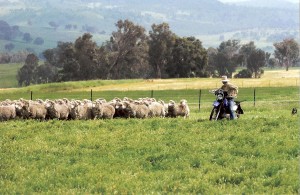
Both measured data and visual classing records are available to clients at any time
At the classing in September all rams are scored for a range of visual traits.
This visual assessment data is recorded and is used at the final classing in December – January in combination with the recorded data on measured traits to provide a full evaluation of all rams, particularly those involved in the progeny testing program.
All recorded data for both measured and visually assessed traits can be made available to clients when purchasing rams at any time.
The Progeny Testing Program
The aim of the progeny testing program is to improve the accuracy of the estimation of the breeding value of the young sires which at this stage is based on their own performance as a hogget and pedigree information from sire and dam. While a ram’s own performance is a reasonable indicator of its breeding value, the performance of his progeny is a true indicator of his genetic value.
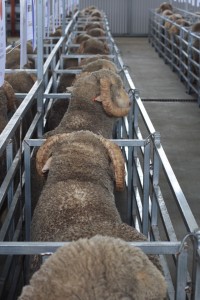
The performance of a ram’s progeny is the only true indicator of his genetic value
Every year at Nerstane nine young sires are selected for evaluation in a progeny testing program. The progeny testing program is also linked to the Central Test Sire Evaluation program by including a sire that has already been evaluated in Central Test or has been used in the stud, i.e. a proven sire. This ‘linking’ enables the young progeny test rams to be evaluated against rams in the Central Test program and older sires in use at Nerstane.
It is also important that environmental or non genetic effects such as management differences do not influence the results of the progeny test. To guarantee this, all ewes involved in the progeny testing program are run together except for the four week joining period and lambing period. After the lambs are identified all ewes and progeny receive identical treatment until their performance is measured and assessed.
All introduced sires are subjected to the same progeny testing program and are only used further in the stud if they perform better than the home bred sires.
The Ewe Selection Program
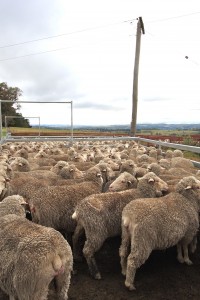
All ewes are candidates for selection into the stud
All ewes bred in both the stud and commercial flocks are involved in a thorough selection program which is designed to identify the most productive replacements to promote to the ram breeding level.
By having all ewes as candidates for selection, the selection pressure for both visual and measured traits is substantially increased.
Details of the program are presented in the table below.The stud ewe flock of 2000 ewes is divided into two tiers on the basis of measured performance (Index rank) and visual excellence. The top tier (Special Studs) consists of 600 ewes which are joined in single sire joining groups to proven sires identified through the progeny testing program.
| TIMING | SELECTION EVENT |
| August/September | Lambing – lasts for 6 weeks with the majority born in first 3 weeks. |
| December | Weaning and tip shearing to ensure accurate fleece weights at the next shearing (i.e. so that the 6 week difference between the first and the last lamb born is eliminated). |
| September (early) |
1 year old visual classing and scoring for 10 traits. Approx. 35% identified as visual culls. |
| September (late) |
All ewes shorn, fleece weighed, mid side sampled and scored for style and fleece rot incidence. |
| February | Final visual classing with the aid of fleece weights and fibre diameters. Stud and flock ewes selected. A further 5% are culled. |
| March/April | All ewes joined (6 weeks) |
| April | Stud ewes (1.5yo) shorn again, fleece weighed and fibre diameter tested. (2nd Stage test). This data is used to finalise grade ie. Special stud, stud or flock. |
The AI program is also conducted at this level. Semen is purchased from carefully selected rams that have a proven record in the industry. Performance data from Central Test Sire Evaluation programs is highly regarded when choosing AI sires.
Stud ewes not involved in the progeny testing program are syndicate joined to the remaining proven Nerstane sires. When the ewe syndicates are selected, the finer ewes are allocated to a separate syndicate (fine stud syndicate).
